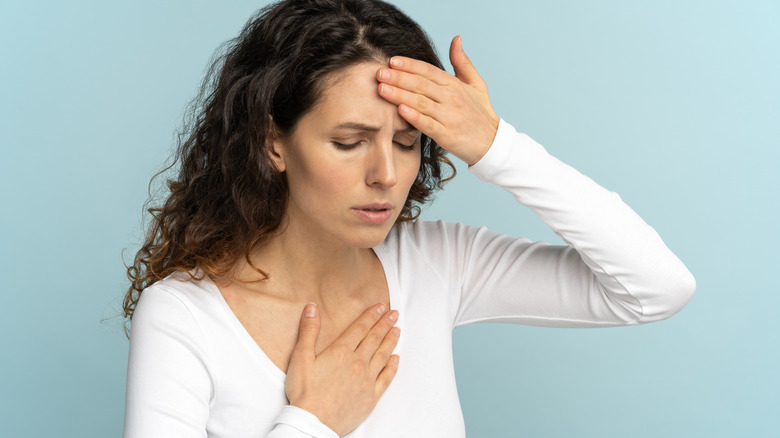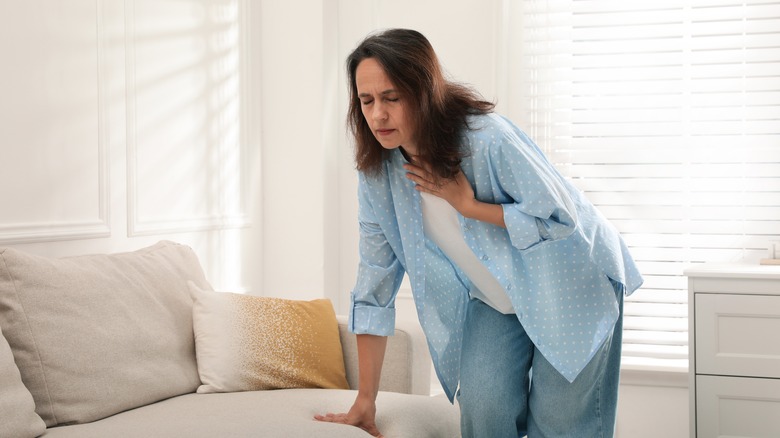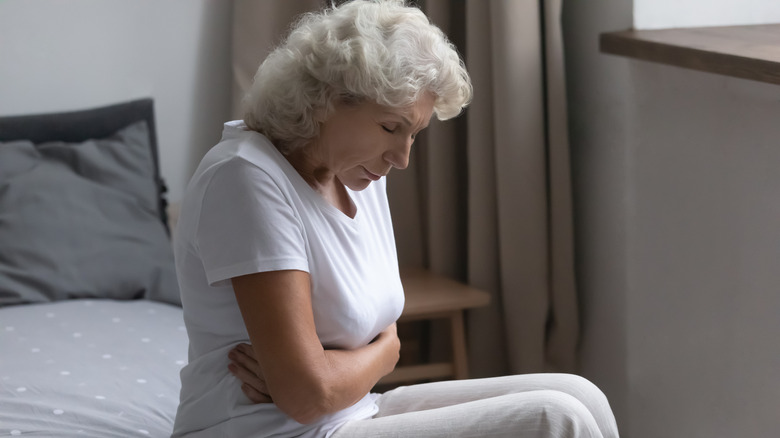Sudden Sweating And Other Cardiac Arrest Symptoms Women Experience
For years, scientific research has primarily catered to men and their specific health issues. Medical textbooks and studies are authored using information gathered from analyzing men. By leaving women out of the equation, the specificities of women's health are often left undiscovered.
According to Fortune, including women participants in clinical trials was not a requirement until 1993. With decades of catching up to do, women face unnecessary blockages when it comes to proper healthcare. When it comes to hundreds of different diseases, they are often diagnosed much later than men.
This patriarchal tradition can have deadly consequences, explains Cedars-Sinai. A long-term study completed at a Florida emergency room showed that there were a higher percentage of female patients that succumbed to heart attacks than men.
While there is growing information about signs of a heart attack in women, research still seems to lag about cardiac arrest signs, despite women making up 40% of cases of sudden cardiac arrest. Often resulting from a heart attack, cardiac arrest occurs when the heart's rhythm stops, ceasing the pumping of blood throughout the body (via UCLA).
Although they are not the same thing, heart attacks and cardiac arrest share similar signs. As a common precursor to cardiac arrest, it's important to learn the signs of a heart attack.
Sweating and fatigue are common signs for women
As women get older, the risk of heart attacks increases. The age at which women are susceptible to heart issues overlaps with when menopause starts to take effect. While sleepless nights caused by hot flashes and night sweats are common at an older age, Healthline stresses the importance of understanding the difference between routine hot flashes and something deeper.
Excessive sweating can occur due to the strain that's put on your heart when it's having difficulty pumping blood through obstructed arteries. As the body heats up, sweat increases in order to cool you down.
Aside from waking up to sheets dripping in sweat, intense fatigue is another sign of a heart attack. While chest pain is a common indicator for men before a heart attack, Harvard Medical School says that many women report fatigue as the top symptom they experienced the month leading up to their heart attack.
Fatigue also occurs due to the exertion of your heart having to pump blood through blocked arteries. Feeling tired after a long day is normal, but if you find yourself feeling completely drained constantly, there may be an underlying heart issue.
Shortness of breath and chest pain are serious symptoms
The heart and the lungs are intrinsically tied together. Like most other organs, the lungs cannot function without the heart. During cardiac arrest, the heart stops pumping blood throughout the body, including to the lungs.
During the blood flow process, blood from the pulmonary artery is transferred from the heart to the lungs. From there, it takes oxygen and flows back to the heart (via Verywell Health). Without the heart being able to pick up oxygen and spread it throughout the other organs, shortness of breath can begin during cardiac arrest.
Chest pain is also another sign of a heart attack. However, it often manifests as tight, squeezing discomfort, per Kaiser Permanente. It doesn't always come as an intense wash of pain. There can be dull pressure in the chest, as if there's something heavy sitting on it.
The pain or discomfort is due to the lack of blood that the heart muscle cells are receiving. This is called myocardial ischemia, a situation in which the heart muscle is unable to pump blood. Although it is not always connected to heart attacks, they can occur in severe cases (via Mayo Clinic).
Pain throughout the body can indicate a heart attack
As the attack progresses, the discomfort from the chest can spread. Aside from the chest, pain can be found in the arms, back, neck, jaw, or stomach. Even if pain is not evident in the chest, noticing sudden pain throughout the body should put you on high alert, Cedars-Sinai warns.
About ⅓ of people who have heart attacks don't feel chest pain. This phenomenon is typically experienced by women, people of color, those older than 75, and people who have a history of strokes, heart failure, or diabetes.
The most prominent pain can often be seen in the stomach. Like other signs of a heart attack, it may be perceived as something else. Since nausea and vomiting are common symptoms of a heart attack, some women may think that they have the flu, or that they're dealing with bad heartburn or acid reflux. If you're experiencing any other symptoms alongside the heartburn, such as sweating, exhaustion, or pain, it could be a heart attack rather than just a bad meal (via Medical News Today).
What increases the risk of a cardiac arrest?
Johns Hopkins Medicine states that a wealth of lifestyle habits and conditions can increase your risk. Excessive drug or alcohol use, smoking, and potassium and magnesium deficiencies can all potentially lead to cardiac arrest.
Aside from a heart attack, cardiac arrest also has other main causes: arrhythmia, an enlarged heart, ventricular fibrillation, and coronary heart disease. If you have any of these conditions or have previously had a heart attack, it's important to find out the ways in which you can lower the risk of cardiac arrest.
If you or a relative have a history of heart problems, speak with your doctor about your concerns and any changes you've experienced. It's important to take any medication prescribed regularly in order to avoid health issues (via Healthline). Exercise regularly and eat a balanced diet as a way to make your heart healthier.
If you're worried that you may be in danger of cardiac arrest, talk to your doctor about possibly getting a defibrillator. You can also ask loved ones or the people you live with to become CPR-certified. Without proper CPR, cardiac arrest can be fatal within about 20 minutes.
With cardiac arrest, the symptoms are much more immediate than a heart attack. While the latter often comes with the warning signs discussed above, cardiac arrest is sudden and results in fainting, lightheadedness, and lack of a pulse (via Cleveland Clinic).
A healthy lifestyle can help prevent heart attacks
Similarly to cardiac arrest, pre-existing conditions may heighten your risk of a heart attack. According to Mayo Clinic, high blood pressure, Type 2 diabetes, and high cholesterol can increase the possibility of a heart attack.
High blood pressure, or hypertension, puts a strain on the heart, creating a buildup of fat and cholesterol that narrows and hardens the coronary arteries. This can potentially cause blood clots to form. Either way, whether through blood clots or hardened, narrow arteries, blood flow from the heart is blocked, resulting in a heart attack (via American Heart Association).
As for diabetes, high blood sugar can destroy blood vessels and nerves around the heart over a period of time. Being overweight, not exercising regularly, and consuming high amounts of saturated and trans fats, cholesterol, and salt can lead to a heart attack, reports the CDC.
Aside from eating healthy and getting the recommended amount of exercise, one of the most important things you can do is learn how to manage stress. Better diet and exercise choices are key, and meditation has scientific benefits that can help you with the stress and anxiety that leads to heart problems.
You can also get tests such as an EKG or echocardiogram that will tell you what condition your heart is in, indicating the changes you may need to make in order to better your health.





